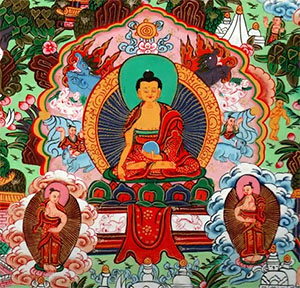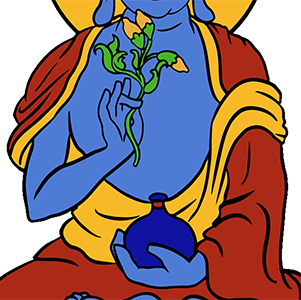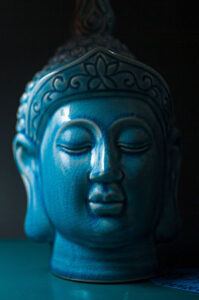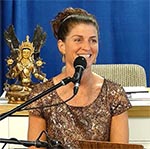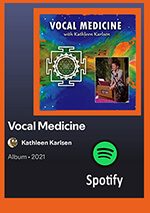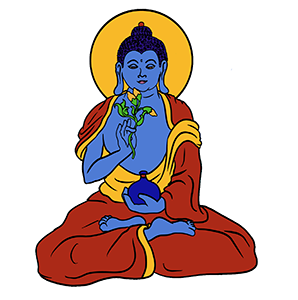
Medicine Buddha Mantra
A Complete Guide to Extraordinary Healing
The Medicine Buddha Mantra comes from the Mahayana Buddhist tradition. The oldest known references to the Medicine Buddha are texts from the seventh century. This article includes the meaning of the Medicine Buddha Mantra, the symbols associated with the Medicine Buddha, how to use the mantra, the vows of the Medicine Buddha, the author’s extraordinary personal experience with this mantra, and the significance of the number 108.
Watch nearly 400 videos on the Vocal Medicine Channel!
Share this page with a friend!
Medicine Buddha Mantra Meaning
The words to the Medicine Buddha mantra are as follows (Sanskrit): “Tayata Om, Bekandze Bekandze, Maha Bekandze, Randze Samu Gate Soha.” Most translations of this mantra are: “May the many sentient beings who are suffering be freed of all pain including disease, death, and karma. May this suffering never arise again.”
Mantra to Alleviate Suffering
The word “bekandze” means “the elimination of suffering” and is repeated three times for the removal of suffering on the physical, emotional and spiritual levels. The three repetitions can also be viewed as eliminating the three poisons of ignorance, hatred, and attachment. The Medicine Buddha is described as a doctor who cures suffering using the medicine of his teachings.
Pronunciation of the Medicine Buddha Mantra
Ta-yah-tuh Om, Be-KAN-dze Be-KAN-dze Mah-ha Be-KAN-dze, Rah-dza Sa-mung-gah-tay, So-huh
Word for Word Mantra Meaning
Tayatha: like this
Om: signifies the totality of one’s being and the universe
Bekandze: eliminating pain or eliminating suffering
Maha bekandze: eliminating great pain, suffering in the soul
Randza: king or sovereign
Samudgate or Samu Gate: ocean of goodness
Soha: blessing, devotion, gratitude from which the realization comes
What is a Buddha?
“Buddha” is a type of honorary title. The word means “awakened.” A Buddha is one who has attained Bodhi or an ideal state or wisdom and perfection. The original Buddha, traditionally known as Gautama, lived around 500BC. His life and teachings form the basis of the historical and modern Buddhist tradition.
Core Teachings of Buddhism
The core teachings of Buddhism are the the Four Noble Truths: The truth of suffering, the cause of suffering, the end of suffering and the path that leads to the end of suffering. Much of the emphasis in Buddhism is on the impermanence of life.
Schools of Buddhism
Today there are many branches or schools of Buddhism. Some emphasize particular aspects of the original teachings. In some cases, the teachings have been further developed. Specific groups may also favor different forms of meditation or spiritual practice.
Role of the Medicine Buddha
The central Medicine Buddha is part of Chinese, Japanese and Tibetan Buddhism. There are temples dedicated to his veneration and sutras referring to the Medicine Buddha in various places in these regions. In addition to Mahayana Buddhism, there are practitioners in Vajrayana Buddhism who recognize the Medicine Buddha.
Who is the Medicine Buddha?
The Medicine Buddha is one of eight healing Buddhas. Healing has been a significant part of some Buddhist sects. The central Medicine Buddha is also known as the Bhaisajyaguru, Master of Healing, Supreme Physician, Supreme Healer and the Healing Buddha.
Tibetan Form of the Medicine Buddha
In Tibet he is known as Sagye Menla. He is also called the “King of Vaidurya Light.” Vaidurya is a brilliant sapphire blue. These rays are said to emanate from his form, dispelling imbalances in the three humors or doshas.
Medicine Buddha Pure Lands
There are six other emanations of the Medicine Buddha, sometimes called the Six Brothers, each which his own color and pure land. These “pure lands” are created as a form of compassionate action on the part of the buddha. They are havens for spiritual dedication. The seventh healing buddha is Shakyamuni Buddha or Gautama Buddha. Each of these buddhas cure a different variety of illness.
The Blue Medicine Buddha
The main Medicine Buddha is blue. The Medicine Buddha is believed to be based on a being who once lived on earth and purified himself through many embodiments. Some of the others are gold, yellow, pink, and orange. The following is a summary of the characteristics of each healing buddha.
Eight Healing Buddhas
Medicine Buddha (Bhaisajya): The central Medicine Buddha holds a myrobalan bearing three ripe fruits. His Pure land is called Sudarshana, meaning “Beautiful to behold.” The myrobalan tree grows here as well as other medicinal trees, plants and herbs. In addition, there are precious minerals, healing waters, fragrances and other aids. He is sometimes depicted seated on a lotus throne.
Sunaman Healing Buddha: This healing buddha is also known as Supari Kiritita Nama Sri Raja or the “Glorious King with the Renowned Name.” Sunaman is usually shown making a mudra or gesture of protection with his right hand and a meditative gesture with his left hand.
Svaraghosa Raja: A healing buddha whose name means “King of Melodious Sound.” This buddha is golden yellow. Svarghosa grants blessings with his right hand and holds his left in the dhyana or meditation position.
Suvarna Bhadra Vimala: This healing buddha’s name means the “Golden, Excellent and Stainless One.” This buddha is an orange-red color. His right hand is placed in front of his heart in the gesture of teaching. His left hand is in the meditation mudra.
Asokottama Shri: This healing buddha’s name means “Gloriously Supreme without Sorrow.” He is light crimson. He sits with both hands in the dhayna mudra of meditation.
Dharmakirti Sagara Ghosa: This healing buddha’s name means “The Dharma Proclaiming Sound of the Ocean.” Dharma refers to the eternal and inherent nature of reality as well as an individual’s duty as fulfilled in accordance with one’s nature, social order and right behavior. His color is white. He makes the teaching gesture with his right hand and the meditation mudra (dhyana) with his left.
Abhijna Raja: Abhijna Raja’s name means “King of Supreme Knowledge.” He is coral red. He sends a blessing with one hand and uses the meditation mudra with the other.
Shakyamuni or Gautama Buddha: This buddha is golden-orange in color. He makes the earth-touching mudra with his right hand. This gesture symbolizes the moment when he attained enlightenment under the bodhi tree. Shakyamuni holds his left hand in the meditation mudra. Shakyamuni means the “Sage of the Shakyas,” a clan name. Gautama was born as the prince of the Shakyas.
Symbols of the Medicine Buddha
The Medicine Buddha is depicted sitting in the lotus position, adorned with rich robes. He has a serene expression with eyes partially or fully closed. The Medicine Buddha is often depicted holding a medicinal plant called myrobalan in his hand. Some believe the plant reduces inflammation and internal bleeding.
Dispensing the Nectar of Immortality
The Medicine Buddha also often holds an alms bowl or a medicine jar in the other hand. The Medicine Buddha is associated with the semi-precious gemstone lapis lazuli. The lapis lazuli jar dispenses amrit or amrita, a nectar of immortality.
Texts of the Medicine Buddha
Early depictions of the Medicine Buddha occurred from the 4th to 6th centuries. This was the Gupta period in India. Many historians view this as a golden age in India. The Medicine Buddha was featured in texts including the Sutra of the Medicine Buddha and the Pure Lapiz Lzuli Light Tathagata Sutra.
Myrobalan Healing Plant
The myrobalan is a plant native to South Asia from India and Nepal to China, Sri Lanka, Malaysia and Vietnam. Myrobalan has been shown to increase heart contractions without changing the heart rate. This plant is also known for benefits to the skin and wound healing.
Medicinal Uses of Myrobalan
Myrobalan is also known as haritaki. The fruit of this tree is the part that is used medicinally. Some sources claim that myrobalan can positively impact cognitive functioning, sexual health, digestion and blood sugar levels.
Lapis Lazuli Healing Stone
Lapis lazuli is affiliated with intellect, wisdom, strength and courage. Lapis is said to provide the wearer with spiritual protection from negative influences. Within Vajrayana Buddhism, the deep blue color is thought to have a purifying and strengthening effect on those who meditate on the stone or visualize the beautiful blue stone. Many depictions of the Medicine Buddha also show him with blue skin. Explore theories about spiritual beings with blue skin in the related article Krishna: Blue Skinned Deity.
Power of Lalis Lazuli
Lapis lazuli is specifically connected to the throat chakra. The throat chakra is the focus for communication and self-expression, including the use of mantras. This dark blue stone also represents intuition and higher awareness. Lapis Lazuli’s association with royalty dates back to 4000 BC and were buried with Egyptian royalty and carved into pendants. The purpose of this stone is to inspire clear and truthful expression by enhancing intuition and spiritual awareness.
Amrita, Nectar of Immortality
Amrita is said to be carried by the Medicine Buddha in the lapis lazuli jar. Amrita is the name for a substance purported to be produced by the body during deep states of meditation. This substance flows from the pituitary gland into the back of the throat. Amrita is a divine nectar that is believed to grant a very long life.
How the Medicine Buddha Mantra Works
In an energetic universe, scientists are finding that matter is always divisible. The universe may be infinitely small as well as infinitely large. Therefore matter is never permanent and is always undergoing transformation. Mantras operate in this realm of energy, vibration and transformation.
Body-Mind Practices
Scientific evidence indicates that meditation and chanting are body-mind practices help to trigger repair mechanisms within our bodies. The Medicine Buddha Mantra can be given for oneself or for another. Some practitioners advise that the mantra be given 108 times.
Visualization and Meditation
According to Buddhist teachings, all the deeds we have performed in life have created our current state on all levels. Practices that purify the mind and soul can help to correct a negative state in the body. Visualization of rays of light can add to the effectiveness of mantras and meditation and assist in maintaining optimal health.

Using the Medicine Buddha Mantra 108 Times
The number 108 has significance in several ways. According to Vedic teachings, there are 108 nadi or lines of energy that extend from the heart to the rest of the body. Each repetition is of a mantra is said to flow along one of these lines.
Letters in the Sanskrit Alphabet
Although there are some differences in how the Sanskrit language is standardized, many experts say there are 54 fundamental letters. Each of these letters have a masculine and a feminine component, bringing the total to 108.
Power of 108 and the Chakras
The letters of the Sanskrit alphabet are said to correspond to the petals on the lower six chakras. Reciting the Medicine Buddha mantra 108 times would stimulate each of the petals for these chakras: root chakra, sacral chakra, solar plexus chakra, heart chakra, throat chakra, third eye chakra.
Numerology and the Number 108
The number 108 is also said to have astronomical significance. For example, the average distance from the earth to the sun is 108 times the diameter of the sun. The average distance of the earth from the moon is approximately 108 times the diameter of the moon.
Other Uses of the Number 108
Because of the significance of this number is Eastern spiritual thought, many temples have 108 steps. Many deities are given 108 names. There are said to be 108 gopis or attendants for Lord Krishna. The measure of the internal angles in a pentagon (considered to be a holy shape) is 108 degrees. In numerology, 108 is called the Universal Number. The 1 stands for consciousness, the 0 for completeness and the 8 for infinity.
Mala Beads and Rosaries
If you are using mala beads to count mantra repetitions, going around the beads a single time is 108. The Western rosary has 54 beads, exactly half of a set of mala beads. Using mala beads makes it easy to chant the Medicine Buddha mantra 108 times.
Medicine Buddha Vows
The Medicine Buddha is the name of a bodhisattva: one who has pledge to remain with earth until all beings are liberated. The Medicine Buddha made 12 great vows. A succinct version of these vows are as follows:
- I vow that my body shall shine as beams of brilliant light on this world and that my teachings shall remove all ignorance. May all beings attain enlightenment like the Buddha.
- I vow that my body be like crystal, radiating rays of light to every corner and bringing wisdom to all beings. May all beings strengthen their spiritual power and physical energy to fulfill their dreams and purposes in life.
- I vow that I shall grant through boundless wisdom all the things that beings require, and relieve them from pain and guilt resulting from materialistic desires. All shall be generously shared so that all live harmoniously together.
- I vow to lead those who have gone astray back to the path of righteousness. Let them be corrected and returned to the way of the Buddha.
- I vow that I shall enable all sentient beings to observe precepts for spiritual purity and moral conduct. All shall be guided by repentance.
- I vow that all beings who are physically disabled or sick shall be blessed with good health both physically and mentally.
- I vow to relieve all pain and poverty. The sick be cured, the helpless be helped, and the poor shall be assisted.
- I vow to help women who are undergoing suffering. By hearing my name, paying homage and praying, their wishes will be granted and they will ultimately attain Buddhahood.
- I vow to free all beings from evil thought. I shall lead them onto the path of light through righteousness and honor.
- I vow to save prisoners who have genuinely repented. I will save victims of natural disasters. My supreme powers will bless those who are sincere.
- I vow to save those who suffer from hunger and starvation. If they hear my name and faithfully cherish it, I favor them with the best food that they may eventually lead a tranquil and happy life.
- I vow to save those who suffer from poverty, tormented by mosquitoes and wasps day and night. If they cherish my name with sincerity and practice service to others, they will be able to achieve their wishes.
Watch nearly 400 videos on the Vocal Medicine Channel!
Author’s Experience: Medicine Buddha Mantra
“I got up an autumn morning in September with a desperate feeling. I had been taking my 15-year-old son to a doctor regularly for about three weeks to have an infected wound cleaned and packed with antibiotics. We had just discovered that he had a series of large cysts just below his spine.
The cysts were interconnected and had broken through to the surface. It was a mess. The surgeon wanted to clear up the infection before doing surgery to remove the cysts. Unfortunately, things were going from bad to worse.”
Finding the Medicine Buddha Mantra
“I had been chanting daily as a spiritual practice for almost four years, usually early in the morning. At the time I was doing a 30-minute session of livestream mantras each weekday online, usually joined by several others virtually. It was about 4am when I woke up that day. With the ominous feeling hanging over me, I immediately started searching on my phone for a mantra for healing.
Fortunately, I found the Medicine Buddha Mantra. After listening to several versions, I wrote a quick melody of my own. At the end of my livestream session that morning, I explained the situation with my son briefly and led the Medicine Buddha Mantra for the first time.
As the day went on, my feeling of dread grew. By lunchtime I was so stressed out that I was feeling physically ill. I went to bed. Then I had the idea that I should record the Medicine Buddha Mantra. I dragged myself out of bed, went downstairs to my basement and recorded the chant on a single take, then rushed off to pick up my son from school to take him to his medical appointment.”
Unexpected Surgery for My Son
“Arriving at the doctor’s office, we were informed to our great surprise that he was going in for surgery immediately. The infection was too significant to continue to treat with antibiotics. We were told to report upstairs to the operating room. The plan was for two surgeries. First the infection would be cleaned out. Then in a couple of months a second surgery would be performed to remove the cysts.
My son was prepped for the operation. I called family and friends to let them know what was going on. By the time the surgery was in progress, we were well into the evening and the hospital was deserted. This was September 2020 at the height of COVID concern. I was only allowed to remain on the premises because my son was a minor.”
Medicine Buddha Mantra in the Waiting Room
“No one else was in the waiting room. However, there was a beautiful grand piano. The piano was covered with a tarp and marked with a sign instructing musicians to call the central desk for permission to play. I called. The operator gave me permission immediately. By this time it was dark outside. The expected 45 minutes of surgery was passing rapidly. I sat down and played and sang the Medicine Buddha Mantra.
After about an hour, a nurse called to let me know that the surgery was going longer than expected. Finally the surgeon finally called to let me know he was finished. The problem had been more extensive than he had realized. He had to be very aggressive. Now. The only good news was that there would not be a second surgery.
The surgeon had removed a significant amount of soft tissue and skin, all the way to the bone and the fibrous connective tissue surrounding the spine. There was no way to suture the large surgical wound. My son would be on a wound machine for weeks or months to come to drain the site and prevent infection.”
Through the Night with the Medicine Buddha
“I was in shock. Just weeks ago, I had no idea that anything was wrong. The surgeon said he estimated that my son had been battling the infection and cysts at some level for one to two years. My son had not complained or even told anyone about the situation until the pain became constant. We discovered later that he had actually stopped growing during that period. He had been large for his age, so we had not noticed or been concerned.
I slept in a chair next to my son’s hospital bed that night. Every time I woke up, I could hear that somewhere in my consciousness the Medicine Buddha Mantra was playing. In the months that ensued, the Medicine Buddha Mantra became an anthem of hope and healing. Some of those who had been coming to my online events began to use this recording to chant and pray for my son.
A friend loaned me a hand-painted tanka of the Medicine Buddha in those early months after the surgery. This is the image used in the Medicine Buddha Mantra video. Another friend lent me a beautiful blue statue of the Medicine Buddha to put in my music room as a focus for my own chanting and prayers.”
Recovery with the Medicine Buddha
“My son was released from the hospital with a portable version of the wound vac machine. He was constantly connected to the machine for thirty-three days. For the next four months, we went to the Wound Clinic three days a week for his bandages to be changed and the wound to be cleaned. Eventually I learned to do this twice a day myself. My son was finally able to return to school in late January.
The Medicine Buddha Mantra was a life raft for me during this difficult medical situation. The mantra has remained as a central part of my chanting repertoire. I find the Medicine Buddha Mantra appropriate for so many situations and for the world at large during challenging times.
I am so grateful for the Medicine Buddha Mantra and for all of those who chanted and prayed so faithfully on behalf of my son. Please feel free to use this as a musical meditation for any situation or loved one in your life in need of healing.”
NOTE: I would love to hear your story! Contact me any time to share your own experiences with the Medicine Buddha mantra.
Reader’s Medicine Buddha Testimonial
“Singing the Medicine Buddha mantra spontaneously healed a recent episode of cluster headaches! I had started a bout of painful cluster headaches after not having one for over 10 years. One came on right before I was about to leave to go to Kathleen’s house for a gathering on Saturday night. I texted her to let her know I wouldn’t make it to the event.
Kathleen told me that she was going to chant the Medicine Buddha mantra for 10 minutes and to see if it connected with me. I went to her website and pulled up the Medicine Buddha mantra. I sang along during those 10 minutes. Low and behold, my headache went away!
The next morning the headache came back. I sang the mantra again and it went away again. This morning I could feel one starting to come on and sang the mantra and the headache never even made it into my head! Now I am empowered to do something to feel better during these mysterious episodes of cluster headaches.
I’ve learned that singing mantras presses the tongue to the roof of the mouth, stimulating the hypothalamus. Medical practitioners believe this has to do with these sorts of headaches. I’ve been singing mantras for years and this is the first time I’ve experienced healing a specific condition with one. I am in awe and so grateful to be healing with Kathleen’s help! She knew just what I needed.”
A.C., Bozeman, MT
Resources: Bhaisajyaguru: The Medicine Buddha
Author Kathleen Karlsen
Kathleen Karlsen is a musician, artist, writer and speaker. She is the author of two books (Flower Symbols and Vocal Medicine) and over 200 articles. Kathleen, her husband Andrew, and their five children live in Bozeman, Montana. More about Kathleen Karlsen.
MEDICINE BUDDHA ARTICLE SUMMARY
This article on the Medicine Buddha mantra includes symbolism and iconography, the history of healing in the Buddhist tradition, the vows of the Medicine Buddha and the author’s own story of finding this mantra. Her extraordinary experience with the mantra took her through a difficult time when her son needed unexpected surgery. Includes two videos and numerous illustrations of the Medicine Buddha.
Click for all content on our Site Map
Watch nearly 400 videos on the Vocal Medicine Channel!

